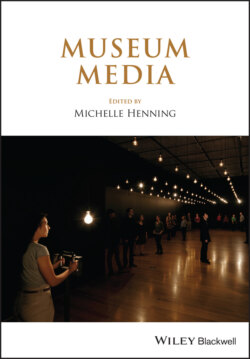Читать книгу Museum Media - Группа авторов - Страница 51
Conclusions
ОглавлениеIn True to Nature, Parsons explained that when he first proposed a “definitive natural history series” to the BBC’s senior management, his series was to be “the television equivalent of all the glossy Time-Life nature books and other noted coffee table volumes rolled up into 20 programmes” (1982, 310). If, in the early 1970s, Parsons proposed to engage in the transmediation of the then prominent genre of the nature coffee table books, in the late 1980s he proposed to engage in an analogous translation: to revolutionize zoos and museums by creating an “electronic” zoo – or what might equally be described as an electronic science museum.
That he could gather the resources to build it suggests an affirmative answer to the first question that I posed in the introduction to this chapter: a museum, or rather a museum designer, can so blur the boundaries between the museum genre and a medium of mass communication as to transform the museum into what I have described as a peripatetic version of whatever medium is transmediated. There is, however, always a gap between what is said and what is done, and indeed between what is said and what is done in saying. It is clear that Wildwalk was no more a peripatetic version of a wildlife documentary than Life on Earth was itself an audiovisual version of Time-Life coffee table books. Both were sui generis media which might be linked in various ways to earlier media, but which had a semeiotic logic completely different from that of their ostensive predecessors.
What was true for Wildwalk is bound to be true for any such attempt in any other context: the genres of wildlife documentaries, zoological gardens, and science museums have intricate and subtle cultural ecologies; while it might seem that success in one medium, one technology may provide a springboard for success in another, this chapter has made clear that decontexualizing aspects of any one mode or genre, let alone several, and then transposing them to another, is likely to lead to semeiotic transformation – at times, completely unforeseen transformation.
Such change is more likely if one takes for granted that any one genre’s techniques of observation are inherently superior to those of another. It seems clear, for example, that Parsons assumed that the mobility afforded by a cinematographic observer was necessarily a good thing; the same was true of his attempt to build on the apparent rhematism of living plants and animals in zoos. But in the context of participatory science museums, Exploratorium founder and physicist Frank Oppenheimer once explained why the opposite might be true:
Sightseeing through these media [classrooms and television films] resembles sightings from the windows of trains that are unstoppable, irreversible, and dominated more by the smells, sounds, and motions of the train than by the landscape. Sightseeing is invariably unsatisfactory where the main concern is a rush toward a destination or a need to catch the next train. The best kind of sightseeing involves some exploration and the freedom to decide what not to investigate and where to linger. The more one can become involved with the sights through touching, feeling, smelling, and activity, the more rewarding it can be. It is nice to be able to linger and backtrack. (Oppenheimer 1972, 980)
Unforeseen semeiotic dynamics are also more likely if it is assumed that modes of representation are automatically amenable to recombination. Wildwalk illustrated this problem insofar as it did what Parsons himself criticized in museums and zoos, namely, at times it simply “glued on” audiovisual images to object-based displays. Worse, the attraction’s black box, in both the architectural and cybernetic senses described earlier, at times seemed to “glue” real animals to the visitor attraction, with little more than a superficial regard for the pedagogic consequences of this remarkable inversion.
The reference to pedagogy leads me to a final point. In environmental education it is common to make a distinction between formal and informal modes of pedagogic communication. Less acknowledged is something akin to the “shadow” of both of those modes, a nonformal mode, for which something may be taught without being taught, and something may be learned without being learned (Lindahl Elliot 2006a, 4). Neither the science educator nor the museum attendee set out to teach or learn something deliberately, but something is nevertheless taught and learned unselfconsciously.
In Wildwalk’s case, Parsons wished not only to promote a better understanding of biodiversity, but to convey the beauty and sheer magnificence of the evolutionary process. However, anecdotic evidence gathered by staff at Wildwalk and during my own observations at the museum suggested that many visitors failed to perceive the overarching narrative about growing evolutionary complexity. On the contrary, many thronged around either the exhibits that were more zoo-like (e.g., the aquariums or the tropical house), or those that offered opportunities for instrumentalizing relations with nature (e.g., “The Hunting Gallery”), and did so oblivious of questions of evolution, biodiversity, let alone growing complexity.
The last point returns us to the issue I raised at the outset about technological determinism. Genres involve not just techniques and technologies of communication, but also a horizon of expectation shared by the audience. The lived logic of this generic “inertia” may ultimately escape even the most carefully planned transmediations. This is a problem that was reflected in Wildwalk’s struggle not just to achieve higher attendance levels, but to find an appropriate name and description for itself. The attraction’s changing names may be taken as an index, in Peirce’s sense of the term, of the challenges of transmediation.
